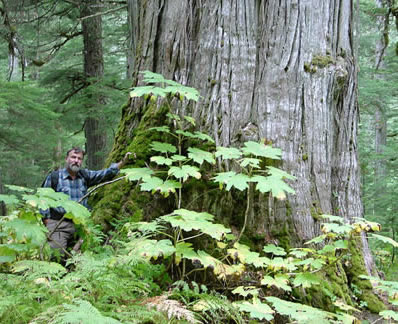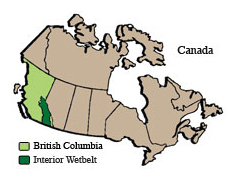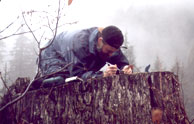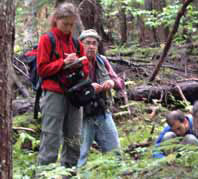|
British Columbia’s Ancient Inland Rainforest Reveals Biodiversity Previously Unknown to Science
BC’s Interior Wetbelt
The “Interior Wetbelt” of British Columbia (BC) is the home of BC’s Interior Cedar-Hemlock forests. These humid, coniferous forests harbour the world’s only mountain caribou and the world’s only Inland Temperate Rainforests. The old-growth may have giant Western Redcedar trees 500-1,800 years old. These forests have been heavily logged for forty years while little attention was paid to the biological wealth that was being lost. Now, with a closer look by scientists from Canada, Germany and the US, these forests are yielding more newly discovered species than any other region on Earth. However, this recently discovered cradle of diversity is increasingly threatened by the surge of industrial forestry. |
 |
 |
BC lichenologist Trevor Goward, Curator of Lichens at the University of BC, has been studying the inland rainforest for many years. But in general, the rugged mountains kept many of their biological treasures hidden in remote wilderness valleys. Tragically, it was loggers who were often the first — and the last — to see them. In the Adams River Valley, in the Incomappleux (Fish) River Valley, kilometre after kilometre of ancient forest was levelled to the ground by chainsaws. In the mid 1990s, wilderness explorers began to contact environmental groups, which began to alert scientists to the growing hemorrhage of biodiversity. That is how the clearcutting of the upper Incomappleux Valley (shown above) was stopped in 2003, just short of a 2 meter thick, 1,800-year-old tree.
|
Sensing something different about the Incomappleux forest, explorers Gary Diers and Tom Prior contacted the Valhalla Wilderness Society. VWS escorted lichenologist Toby Spribille, from the University of Göttingen, Germany, into the Incomappleux. Indeed there was something different. Its location near Revelstoke made it the most southerly example of inland rainforest known to scientists; and it had been growing continuously much longer than its oldest trees — perhaps for thousands of years. Its giant cedars could be the first generation of cedars to colonize the area after the last Ice Age. Despite a temporary moratorium on logging, Pope and Talbot, Ltd. still wanted to log what was left. A series of massive natural rockfalls on the road have provided a temporary reprieve; but ancient forests throughout BC continue to fall daily to the chainsaw, and with them unknown numbers of species that may go extinct before even getting a name. |
 |
The Magic and Meaning of Lichens
Imagine a forest in which the trees and rocks are encrusted and draped with literally hundreds of species of elfin lichens. Some are inconspicuous and homely, some suggest an exquisite miniature kingdom fit for fairy tales, others are large, disorderly and lavish on the limbs of trees. They are the product of hundreds, perhaps thousands of years of stable growing conditions in the old-growth forest. The ancientness, the lavishness, of life in these forests can be felt, but that isn’t all.
Many species indicates many functions in the forest ecosystem. Some lichens, like the leafy Lung Lichens (above, left), are natural fertilizers, aiding the growth of trees by capturing nitrogen from the air. The temperate rainforests are poor in nitrogen. How much the nitrogen-fixing lichens contribute to their growth has yet to be calculated. But throughout the world, healthy lichen vegetation has come to stand for a healthy environment.
Many species of wildlife depend upon lichens for food and nesting materials. The black and yellow hair-like lichens hanging from the branches of trees (above, centre) are the sole winter food of the endangered mountain caribou. Many endangered species including the Spotted Owl and mountain caribou rely on lichen totally or in part in their food chain.
|
 |
Until recently, Interior Cedar-Hemlock was believed to be relatively poor in biodiversity. People saw only the more obvious organisms. But working closely with international experts, Toby Spribille (right), currently based in Germany, and Trevor Goward and Curtis Bjork, both from British Columbia, have been intensively studying inland rainforests. In several recent studies, they have found that these forests support one of the richest tree-dwelling lichen floras in the world. Indeed, the number of lichen species equals or exceeds that of all other plants combined.Other species, such as the mosses or the insects, have never been studied intensively over a broad area in the inland rainforest. We don’t know what we are losing.

|
 |




|
The Incomappleux Reveals 13 Species New to Science: More to Come
Goward, Bjork (left) and Spribille continued their inland rainforest studies from Idaho to Prince George at the northern edge of the Interior Wetbelt. Together, they have identified 13 species of lichens new to science. Many others, though known to science, had never before been found inland, but were typical of Coastal Temperate Rainforest. Indeed, some had never before been found in BC, or even in Canada.
In the Incomappleux alone, Spribille found 283 lichen species, of which 213 grow on trees, including nine of the 13 species new to science. “Such levels of lichen diversity and rates of discovery of new species are basically unparalleled in northern conifer forests,” he explains. “We are definitely looking at a major center of lichen diversity at a global level that we haven’t even begun to fathom or explain.” He expects that further research would turn up many more species new to science. Together, the researchers are currently looking at over 40 candidate new species, pending further studies.
About 90% of the nearly 300 lichen species found by Spribille were found in the old-growth forest. “Every valley has a unique set of species which reflects its special environment and history,” says Spribille. “Those growing in old-growth forest have likely grown in the humid canopies of trees for hundreds of years. They will not survive the drying and exposure brought on by logging. We know almost nothing of how these species spread, but repeated experience has shown that they are not found in second-growth forest.”
Valhalla Wilderness Society director Craig Pettitt (left, counting tree rings) has assisted numerous scientists visiting the Incomappleux. In the summer of 2004 Spribille and Bjork were accompanied by German botanist Viktoria Wagner (foreground, left), Dr. Adolf Ceska (middleground, left), formerly with the BC Conservation Data Centre, and BC mushroom expert Dr. Oldriska Ceska (below, left). The Ceskas found the rare Phaeocollybia piceae (below, centre), a mushroom previously associated only with very old coastal rainforest. Sixty-two other mushroom species were found in the old-growth, including 22 species that the inland rainforest has in common with its coastal counterpart. The fern shown below is a rare fern from the genus Asplenium, one of numerous rare plants discovered by Spribille.
North of the Incomappleux, in the Cariboo Mountains and the North Thompson and Robson Valleys, there is much more intact inland rainforest than in this central part of the Interior Wetbelt. But it has been little studied. There could be other Incomappleux Valleys unknown to science threatened by the chainsaw.
 
Logging to Extinction |
 |
FAST FACTS
Total area of the Interior Wetbelt
14.3 million hectares (ha.)
Total forestland: 9.58 million ha, or 65%
Total parks: 7.5%
Logged since 1960: 2 million hectares = 46 years @ 47,679 ha/year
Remaining intact old-growth
as % of forest land base:
Northern half: 28%
Southern half: 20%
Logging is concentrated in the valley bottoms, targetting the old-growth Interior Cedar-Hemlock (ICH) forest. Only 3.2% of the forest land base is intact, low-elevation, old-growth forest.
BC Conservation Data Centre data base:
Red- and blue-listed species in the ICH biogeoclimatic zone: 196
Of these, 32 are listed for no other zone but the ICH. |
East Asia has 4,500-7,350 snow leopards. Africa has 3,725 black rhinoceros. China has 1,600 giant pandas. Canada has 1,900 mountain caribou. Almost all scientific reports over the last 20 years agree that loss and fragmentation of old-growth forest, primarily due to logging, has driven the mountain caribou to the brink of extinction.
The existence of low-mid-elevation old-growth ICH connected to high elevation old-growth spruce-balsam predicts where the remaining subpopulations can be found today.
The mountain caribou is the subject of a recovery planning process under Canada’s Species at Risk Act. Unfortunately, a panel of scientists, unwilling or unable to confront the timber industry, has issued recommendations that offer little additional habitat protection. Instead, they recommend shooting the caribou’s predators (wolves, cougars and bears) and competitor species (moose and deer). It is urgent to immediately protect the ancient forest of the Incomappleux Valley. However, it is not big enough to accommodate the mountain caribou.
It has been included in a larger park proposal first put forward by the Western Canada Wilderness Committee in 1998. Recently, the Valhalla Wilderness Society has used computerized forest cover maps to identify the highest value old-growth forest and mountain caribou in the area. Shortly VWS will release its new Selkirk Mountain Caribou Park Proposal.
In the mountain caribou recovery process, the Species at Risk Coordination Office (SaRCO) has received over 1,200 letters demanding increased habitat protection. The best thing you can do for the inland rainforest right now is write SaRCO a letter at heather.mitchell@gov.bc.ca.
For further information see:
Grassroots Environmental Declaration for BC's Inland Temperate Rainforest
Joint submission to SaRCO signed by 19 groups
www.inlandtemperaterainforest.org
|

|
|
|





